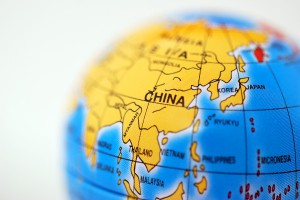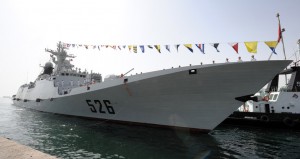By Dr. Richard Weitz
08/03/2011 – The 84th anniversary of the founding of the People’s Liberation Army (PLA), celebrated this Monday, August 1, is a good time to consider the growing power of PLA Navy, not least because the People’s Republic of China (PRC) looks set to launch its first of many aircraft carriers. Today’s column considers the PLA Navy’s intentions; tomorrow reviews its capabilities.
Preparing to defend China’s coastal regions from seaward assaults, occupy Taiwan by force, or support Beijing’s offshore claims in disputed waters are the immediate objectives of the PLA Navy’s buildup. To achieve these goals, the PLA is seeking new capabilities that would enable it to defeat any local adversary while denying third countries the ability to intervene against the PLA.

Although China might be able to win a war exclusively with another Asian country, achieving a favorable outcome would prove much harder if the Pentagon would actively assist China’s opponent. The United States has formal defense alliances with Japan and South Korea. In addition, prudent PLA planners might anticipate possible U.S. military intervention to defend Taiwan and certain other Asian countries against the PRC.
Since the PRC’s founding in 1949, coastal attacks have remained a concern to its military planners, but the recent growth of China’s naval power has led PRC leaders to expect their fleet to avert such threats rather than have to rely on the traditional practice of fighting invaders on land. Beijing has also long extended this territorial defense function to include using its warships, as well as ancillary civilian craft, to transport PLA ground forces to Taiwan.
A more recent function of the Chinese Navy is to defend the PRC’s disputed claims to other offshore maritime territories. This mission reflects PRC leaders’ interest in ensuring China’s access and potentially control over the natural resources—such as fisheries and energy resources— located under the waters surrounding China.
Furthermore, since the PRC became a global trading nation increasingly dependent on overseas energy supplies and other key imports, its leaders have become increasingly interested in protecting their country’s maritime shipping from pirates and other threats.
Unlike China’s past naval strategies, which concentrated on protecting the country’s coastal regions, the PLA Navy’s evolving objectives will likely focus on advancing the PRC’s offshore territorial claims and on securing the PRC’s global maritime trade routes, which have become increasingly important to the Chinese economy.
For now, the PRC national security community remains most concerned with any tensions that might arise in the Taiwan Strait. Due to the U.S. defense commitment to assist Taiwan, the PLA has been preparing to fight not only Taiwanese defenders, but also the United States, in any cross-Strait conflict.
The main objective of the PRC’s military buildup is to enhance its “anti-access/area denial” capabilities to inhibit U.S. intervention in the event of conflict with Taiwan. The anti-access/area denial mission involves deterring through threats, or if necessary disrupting by direct or indirect strikes, any U.S. force coming to Taiwan’s immediate aid.
The PLA’s emphasis on improving its fleet of attack submarines, guided missile destroyers, long-range anti-ship missiles, improved fighter planes, long-range sensors, as well as cyber strike and anti-satellite weapons—all increase the risks to any U.S. naval task force or other units sent to defend Taiwan.
These “anti-access/area denial” capabilities will also prove useful in helping Beijing defend its sovereignty claims in the contested waters of the East China Sea, the Senkaku Islands surrounding Taiwan, and the South China Sea. The East China Sea contains an estimated 100 billion barrels of oil and 7 trillion cubic feet of natural gas. Ignoring Tokyo’s overlapping claims to these waters, the PRC seeks a generously large exclusive economic zone (EEZ), reaching almost to Japan’s shore, which would guarantee access to these resources. The PRC also claims a right, not recognized under international law, to regulate foreign military activities in its 200-mile maritime EEZ.
Beijing claims regarding the South China Sea, which encompasses about 3.5 million square kilometers of water near several countries’ coastlines, have become especially prominent in recent years. In the 1990s, the PRC declared the entire region as falling within its territorial waters. In recognition of the common interest of all the parties in keeping East Asian shipping lanes secure, on November 4, 2002, China and the ten members of the Association of Southeast Asian Nations (ASEAN) signed the Declaration on the Conduct of Parties in the South China Sea. The signatories pledged to resolve their sovereignty disputes peacefully through direct negotiations.
But in March 2010, PRC representatives declared the South China Sea as its “core national interest,” which in diplomatic language normally means an issue a state is willing to use military force to defend. Previously, Chinese leaders had applied that term only to Tibet and Taiwan. Vietnam is the only other country to claim all the small islands in the South China Sea, but Brunei, Malaysia, the Philippines, and Taiwan assert sovereignty over some islands and water areas. The Spratly and Paracel chains constitute the most prominent of the islands, whose small size belie the potential value of the important natural resources, above all oil and natural gas, thought to lie underneath their surrounding waters. The islands are also surrounded by valuable fishing grounds and straddle vital shipping lanes. According to ASEAN Secretary General Surin Pitsuwan, more than 85 percent of the energy resources shipped to China, Japan, and South Korea pass through the South China Sea.
Beyond the goal of being able to secure Beijing’s control over adjacent regions by force if required to do so, the PLA will increasingly seek to enhance its ability to project military power at considerable distances from the Chinese mainland. A long-term objective may be to decrease the global maritime vulnerabilities that China has incurred in recent years as the PRC has become increasingly dependent on access to global resources as well as a major foreign investor in global markets.
As with other global maritime powers, the PLA Navy’s mission could eventually include helping secure the vital shipping lanes that link China to the global economy. Even though the PRC’s economy is mainly powered by coal, its reliance on foreign oil is increasing. Much of China’s oil and other imports transit potential maritime chokepoints like the congested Straits of Malacca. PRC leaders recognize that China’s continuing access to foreign markets, energy supplies, and metals will be vital for the country’s further development.
They also understand that a powerful navy could help China protect its international maritime commerce against potential threats. In 1995, PRC leader Jiang Zemin observed, “We can be sure that the development and utilization of the ocean will be of increasingly greater significance to China’s long range development…we must see the ocean from a strategic plane, and…set out new and higher requirements on navy building. We must…step up the pace of navy modernization to meet the requirements of future wars.”
Historically, securing the safe passage of maritime trade has been an important reason countries have developed strong navies, which in turn become attributes of great power status. Until now, the PRC has depended, for lack of an alternative, on the U.S. Navy to guarantee the security of global shipping.
Missile frigate “Wenzhou” and “Ma Anshan” of the eighth escort flotilla of Chinese People’s Liberation Army (PLA) Navy in the Gulf of Aden are seen in the port of Doha, capital of Qatar, July 30, 2011. Missile frigate Wenzhou, Maanshan and supply ship Qiandaohu arrived in Doha on Saturday, kicking off the first-ever visit by PLA navy to Qatar, which will last for five days.
But Chinese leaders have given indications of wanting to rely more on their own naval capabilities, at least in nearby waters, commensurate with the PRC’s new status as the world’s second-largest economic power. PRC national security analysts, for example, have expressed unease regarding the vulnerability of their crucial Persian Gulf energy supplies and other foreign imports to interdiction by the U.S. Navy.
The PRC is also enhancing its overland transportation networks and constructing more pipelines to transfer fossil fuels by land from Indian Ocean ports as well as Russia and Central Asia, though these networks will likely prove insufficient for ending China’s dependence on maritime commerce.
In what some analysts refer to as a “string of pearls” strategy, PRC leaders have cultivated ties with Pakistan, Burma, and Bangladesh to gain access to support facilities (not formal overseas bases) that give Chinese warships and merchant vessels greater flexibility in navigating the Indian Ocean.
For example, one pearl is China’s access to Pakistan’s Gwadar port, whose construction has been partly funded by the PRC, on the Arabian Sea coast. An increased presence in the Indian Ocean further serves to signal to India, itself undertaking naval modernization, that the PLAN is prepared to defend Chinese interests in South Asia.
The PLA Navy is now developing a fleet of aircraft carriers, large amphibious ships, extensive replenishment and refueling vessels, and other naval instruments to project power on a global scale commensurate with the PRC’s growing overseas economic and strategic interests. These concerns include protecting Chinese nationals and companies operating abroad, supporting PLA contributions to distant peacekeeping operations, and defending the PRC’s maritime imports against pirates as well as potential adversary navies.
Although still awkwardly insisting to be a member of the developing world, the PRC government is also following the leaders of the world’s other rising global powers in seeing, and manifesting, their growing naval power as symbolizing their country’s newly won great power status.
(For a view on the evolving Chinese air capabilities see General Deptula’s assessments https://sldinfo.com/?p=15186 and https://sldinfo.com/?p=14160).
(And for a view on the J-20 see https://sldinfo.com/?p=14637).


